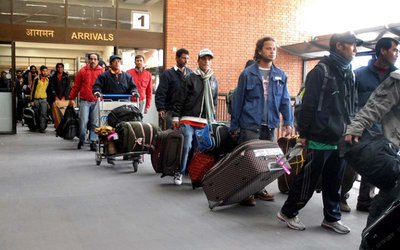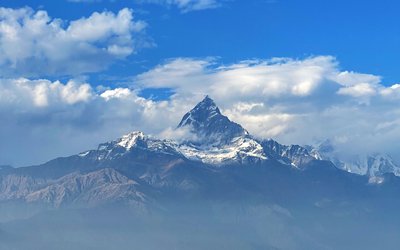
People have a connoisseur within them. They immediately draw attention to everything that piques their curiosity. When it comes to youth, they like traveling, doing new things, and acquiring as much experience as possible in a short amount of time. New, gorgeous, and adventurous destinations excite today's youth. They search for intriguing details, large and tiny, and, most importantly, they seek out new experiences, adventure, and taking chances. Whether it is going on a trip, eating with friends, seeing a movie, or simply hanging out, adolescents find ways to have fun.
Bungamati is an ancient Newar settlement in the Lalitpur Metropolitan City in the Lalitpur District. This settlement has numerous religious and cultural sites such as Machhindranath temple, Hyan bribh Bhairav, Karyabinayak temple, Manakamana temple and Prathampur Mahavihar. It is one of the sacred places for thousands of Hindu and Buddhist. One can see involvement of youth during the procession of various jatras and festivals like machhindranath jatra, bhairav jatra, hanuman jatra, karyabinayak jatra and so on.
Bungamati has a long and illustrious history. All festivals are rooted to folktales that have been passed down from generation to generation. These festivals are fun to attend and are a great alternative to looking at a screen for the entire day. The god Machhindranath, who is also known as the patron of Kathmandu Valley. Month long chariot pulling festival of Machhindranath is a homage to rain god and youth of all backgrounds participate in this festival.
Local delicacies often tell a lot about the place itself. Bungamati has many places where visitors can try out authentic Newari food. Bungamati offers it all, from well-furnished restaurants to tiny eateries. Bungamati is the finest place to experience what a Newar community feels like. In addition to cuisine, youth from every community will get an opportunity to learn about culture, arts and meet people from the Newar community. Also, youth from the Newar community will get a chance to be connected to their roots since it’s no surprise the modernization has disconnected them from their roots.
Tourism has benefited greatly from the use of social media. Because youth are active on social media, content about Bungamati could attract more youth visitors. Sharing pictures among peers, online reviews, online galleries, and any other type of presence on social media can help promote Bungamati as one of the key tourist destinations in the valley among youth.
Bungamati has the charm to appeal to youth, and modest upgrades will bring in more guests. Improvements for a decent water and sanitation facility is one of the areas. Following the Covid-19 epidemic, hygiene is no longer merely a method to gratify tourists, but a fundamental health protocol that every tourist site should adhere to. Bungamati practices traditional subsistence ways, and adding adequate and clean public restrooms, the disposal of household and plastic garbage, and proper recycling of recyclable materials would amaze tourists while also contributing to long-term environmental sustainability.
Bungamati has gone a long way since the 2015 earthquake that struck Bungamati very badly, causing many lives and livelihoods of people. It is estimated that the earthquake destroyed about 54% of the houses completely while 35% were partially damaged, leaving only 11% undamaged. It is believed that almost 83% of houses were built 100 years ago and 17% were built 50 years ago. Unfortunately, those houses carrying historical and cultural values were badly impacted by the earthquake. Efforts for rehabilitation were initiated but they did not continue to meaningful results due to the several concerns such as financial and land ownership issues.
The second major disaster that struck Bungamati was the COVID-19 pandemic, which hit the whole world. Many people who were already living in difficult circumstances owing to poverty further suffered due to the pandemic. In addition, loss of employment, lack of food security, and health issues have affected the livelihoods of people and reconstruction efforts in Bungamati.
European Union’s SWITCH-Asia funded Sustainable Tourism and Green Growth for Heritage Settlement of Kathmandu Valley (Parya Sampada) project, implemented by UN Habitat aims to promote sustainable tourism and green growth in the Kathmandu Valley. The project has been supporting reconstruction activities and improving the livelihoods of people in Bungamati. The project is also supporting preparation of various policy documents for Lalitpur Metropolitan City such as Green Development Policy, Sustainable Tourism Development Policy, and Heritage Settlement Recovery Policy. As youth and women are key beneficiaries of the project, the project has trained 448 youth and 495 women in entrepreneurship development. Similarly, 311 youth and 332 women have been trained in a variety of sectors such as hospitality, handicraft, and cuisine. These activities contribute youth and women to become independent at the same time supporting the Government of Nepal to achieve SDG No. 8- decent work and economic growth.
In addition, the Parya Sampada project has provided various software and hardware supports to youth by providing trainings on advance woodcrafts, homestay management, pickle making, smart agriculture on fruits & vegetables, bhoy (Newar cuisine), advance stitching, bakery, flute, lakhe dance (dance of a demon in the Newar carnival), dhime baja (important musical instrument of Newars), food processing, yomari making (delicacy of Newars), tour guide, entrepreneurship development and so on. These activities have enabled the youth of Bungamati to conserve their both tangible and intangible heritage, thereby expanding economic activities in their localities.
The partnership with local communities to re-build and revive the tourism activity while preserving their traditional values and culture are an exemplary initiative and might just be another reason to visit Bungamati in addition to taste the authentic food, and experience culture and traditions. It is unrivaled in terms of appearance and aesthetics as well. This settlement has all to draw folks in because there aren't many automobiles or people to disturb the serenity, therefore the setting is very peaceful.
Internal tourism has been moving at a high pace these days and the potential to promote it is endless. Visiting Bungamati provides two main messages. The first one is the local culture and second is how Bungamati was able to revive its economy in the aftermath of the earthquake (reconstruction activities) and the COVID-19 outbreak. Internal tourism not only contributes to revive the economy, it also provides various opportunities to the youth of Bungamati. If we examine closely, there are clear linkages among youth, culture, and tourism, hence the youth have a bigger role to play to promote internal tourism and become a part of the local culture, and the economy of the country.
Finally, youth can help a lot to promote Bungamati as a one of the key tourist destinations in the valley since youth are very active on social media, which has hugely contributed to promote tourism. Sharing pictures among peers, online reviews, online galleries, and any sort of presence regarding Bungamati could attract more youths and other tourists as well.
Shrestha is working as an Intern at UN-Habitat.

Sreejan Shrestha
Shrestha is an intern at UN-Habitat Nepal Office
- Youths In Forefront Of Nature, Heritage Conservation
- Jun 03, 2022
- Heritage Revitalization: A Case Of Pilachhen
- Apr 05, 2022












